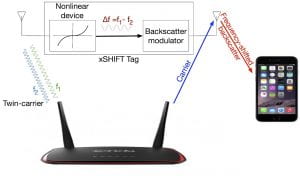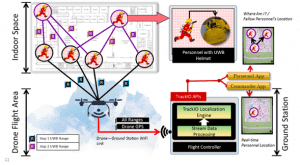My research interests are fairly broad in the areas of wireless and range from networking and systems to mobile sensing and computing. I am passionate about designing theoretically sound algorithms as well as translating them to practical real-world systems. Some of my current areas of interest include:
- Connectivity for 5G/6G wireless systems (RAN, Core, Edge Computing, Dynamic Spectrum Access)
- Low power wireless networking and sensing (Backscatter networks, RFIDs, reconfigurable surfaces)
- ML in wireless (hybrid model-based/free solutions for challenging networking and sensing problems)
- S3C (sensing, connectivity, computing, control) for autonomous systems (AGVs, UAVs, etc.)
For a more recent view of research projects, please refer to my group’s research @ MARGA.
In the recent past, my research had targeted the following thrusts revolving around 5G/6G networked systems, ultra low-power sensing and resource-constrained localization systems (copyright for some of these works, lie with their publishers):
 Autonomous Wireless Networks
Autonomous Wireless Networks
While there have been rapid advances in autonomous systems (micro UAVs, terrestrial AGVs), mobile wireless (cellular) networks have largely remained to be infrastructure-based, relying on a static deployment of base stations. In this research thrust, we explore an alternate, paradigm of rapidly-deployable, on-demand, self-configurable mobile networks that are hosted and driven by such autonomous platforms. Leveraging the autonomy of these platforms, these agile wireless networks can usher in an unprecedented level of ubiquity in wireless connectivity and sensing, provided we can address the challenges that come with mobility. We have architected and built such an end-to-end system called SKYLiTE that is capable of self-deploying and configuring a stand-alone 5G network on UAVs that opens the door for numerous high-bandwidth, low-latency real-time connectivity and sensing applications over large areas. Click to read more.
 Ultra Low Power Sensing
Ultra Low Power Sensing
The future of personal well-being is all about continuous health monitoring through on-body devices (OBDs) like wearables, implantables, etc. and the consequent proactive health management that is made possible. The biggest bottleneck in realizing this vision is the challenging conditions (power, form factor, attenuation, inter-operability, etc.) under which these OBDs need to be deployed and operate, without sacrificing on their capabilities. In this thrust, we aim to remove several of the critical barriers in enabling future on-body healthcare applications. In particular, we leverage wireless backscattering to design novel, ultra low power (micro-W regime that enables maintenance-free operation) wireless tags that can significantly enhance (i) deployment: inter-operate and harvest energy from commodity wireless devices in the environment; (ii) communication: ability to send and receive high data rate signals over practical ranges with high sensitivity; and (iii) sensing: ability to house sensors, while also leveraging its own physical properties to record changes in the surrounding environment. Click to read more.
 Resource-constrained Localization
Resource-constrained Localization
Wireless localization and tracking (L&T) has been extensively studied in the past. However, most of these works target applications that are fairly well resource-provisioned (infrastructure-support, powerful beacons, etc.). Taking L&T to the next level and making them available to practical applications like first responder (infrastructure-free) situations, or massive scale (low-cost, low-power beacons) inventory tracking, requires us to rethink these wireless solutions such that they can efficiently operate under these resource-constrained environments. In this thrust, we take a principled approach to the design of L&T solutions under various such challenging, resource-constrained regimes. In particular, we target (i) absolute tracking in dynamic indoor environments that are characterized by lack of static wireless anchors (i.e. infra-support) and where tracked entities are mobile — this caters to first responder and future multi-player AR/VR gaming applications in everyday environments; and (ii) massive scale tracking, where thousands of entities need to be tracked accurately in real-time at an extremely low cost (cents) and power (micro-W) to make the application feasible — this enables a new level of supply-chain visibility for the era of warehouses and fulfillment centers. Click to read more.
(To learn about these specific research thrusts and projects, please check their respective links. You can access some of the demos here.)
The earlier part of my research career focused on the following three thrusts: (i) wireless connectivity: pushing the envelope in wireless connectivity and access as we head into the next generation (5G) of wireless networks; (ii) software-defined mobile computing: bringing software-defined computing and mobile connectivity together to enable demanding, scalable applications and services in the age of Internet of Things (IoT); and (iii) mobile sensing: leveraging wireless sensing to mine valuable (user) contextual information and enable smart, ubiquitous mobile services in challenging environments.

